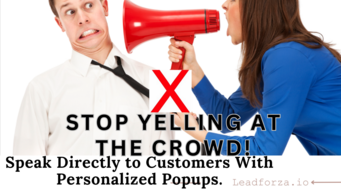Personalized popups: Have you ever been browsing through a website and are constantly bombarded with popups that you do not require?
That is exactly what your users feel when they are browsing through your product page and they keep being interrupted with different unrelated popups.
READ ALSO
- Popup Fatigue: How to Avoid Annoying Your Customers and Keep Conversions Rolling
- The Secret Tool to Sell More Custom T-shirts on Your E-commerce Websites
- Beyond Discounts: 5 Creative Popup Incentives That Will Drive Sales Without Price Slashing
- Personalization Paradox: Striking the Balance Between Relevancy and Creepiness in Popups
- Gamification Power: How Interactive Popups Can Boost Engagement and Sales
- Pop-Up Psychology: 7 Underrated Strategies to Skyrocket Conversions in 2024
- Beyond Exit Intent: 5 Advanced Popup Triggers Ecommerce Stores are Missing out on
- Popups for Customer Education and Support: Providing Valuable Resources
Users share their experience
Let’s read Noah’s experience:
Noah is a dancer with worn sneakers. He is casually browsing the internet for a new pair of sneakers, and he finds himself trapped in a digital avalanche of popups.
Each click on a promising link led to a new window, bombarding him with irrelevant ads. First, a flashy banner insisted on discounted cat food, despite his lack of feline companionship.
Then, a sudden burst of dancing emojis urged him to join a senior dance-off, confusing his age group entirely.
Amidst the chaos, a pop-up survey insisting he rates his satisfaction with a non-existent purchase, aggravating his frustration. Closing one window only birthed three more, like a relentless Hydra of unwanted distractions.
Finally, exhausted and amused, he abandons his sneaker quest, realizing he’s navigated an unexpected maze of digital absurdity.
Noah comments – ‘I was just irritated, and I lost all interest in purchasing new sneakers from that site.’
Also, read Sarah’s story:
Sarah narrates:
‘As I navigated a recipe website, a relentless pop-up salesman hawked kitchen gadgets I neither needed nor desired. Each time I tried to decipher the ingredient list, another ad promising “effortless weight loss” flashed, drowning out the already faint instructions. By the time I reached the oven, my head was spinning, my patience fried and I left the site.’
What problems do you observe from the above stories?
At that time, those popups weren’t just pop-ups.
They were interruptions, attention hijackers, and digital muggers stealing precious moments of focus.
In that online maze, neither Noah nor Sarah felt like a valued customer. Rather, they felt like a target for relentless bombardment. They definitely did not feel as excited as the e-commerce owners putting up those popups.
Instead of being engaged, they were irritated and forced to leave the site.
What lessons can be learned from these stories?
First of all, e-commerce owners must understand that personalized popups can be powerful when utilized properly.
If perhaps those popups in Noah’s story greeted like a friend – ‘Hey, footwear lover! We notice you’re looking for the perfect sneakers. Check out these exclusive sneaker deals.’
Now this is a better online experience that enhances the user’s journey.
The Problem with Generic Popups
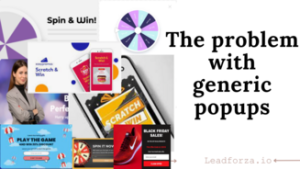
We will now list the drawbacks of generic popups. They include:
- Irrelevant Messaging
- Poor Timing
- Negative Brand Perception
Irrelevant Messaging
These one-size-fits-all blasts ignore the customer’s actual needs, preferences and desires. They’re like chatty neighbours who barge in with news about their goldfish collection while you are fixing a leaky roof.
Irrelevant, distracting, and frankly, annoying.
These intrusive digital nuisances often flood the user’s screen with information that has little or no relevance to our interests.
Another scenario is of a person trying to read an article about healthy recipes, only to be interrupted by popups advertising car insurance or weight loss pills.
These messages not only disrupt the flow of information but also waste the user’s time and attention. The problem lies in the indiscriminate nature of generic popups, as they fail to tailor their content to the user’s preferences or the context of the webpage.
This lack of personalization leads to a frustrating user experience, causing irritation and diverting attention away from the intended content.
YOU MAY WANT TO KNOW – 10 Exceptional Strategies to Boost Customer Engagement with Popups Optimization
Poor Timing
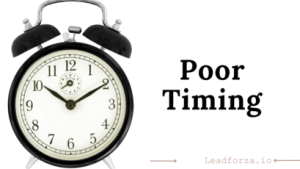
These intrusive messages often appear at inconvenient moments, disrupting the user’s focus.
Imagine watching an intense movie scene or reading a crucial part of an article, only to be abruptly interrupted by a popup deal on lawnmowers demanding your attention.
This disrupts the natural flow of engagement, leading to annoyance and distraction. The problem lies in the lack of synchronization between the popup triggers and user activity.
Generic popups often disregard contextual cues, appearing at times when users are least receptive.
Whether it’s during a form submission or in the midst of scrolling through content, these poorly timed interruptions hinder the overall user experience.
When popups interrupt crucial moments, they break the trust between the user and the website. They no longer feel like a valued visitor, but a captive audience for a relentless sales pitch.
Addressing this issue involves implementing smarter algorithms that consider user behaviour, ensuring that popups enhance, rather than detract from, the online journey.
Negative Brand Perception
When users encounter an excess of irrelevant and poorly timed popups, they associate these interruptions with the brand responsible.
They leave the website with a sour taste in their mouths, and the brand’s once-shiny image tarnishes in their minds.
This can lead to frustration, irritation, and a diminished view of the brand’s credibility. Users may perceive the brand as being pushy or inconsiderate, hurting their overall impression.
The lack of personalization in generic popups makes users feel like just another target, rather than valued individuals.
To combat negative brand perception, businesses must prioritize user experience, implementing more targeted and well-timed popups that align with user preferences.
What Impact does this have on Conversions?
The consequence(s) for any of the above problems can be all or one of the under-listed:
- Lost leads
- Increased bounce rates
- Decreased Customer Satisfaction
The Power of Personalized Popups
Unlike generic popups, personalized popups are preferred and more effective.
Personalized popups are small, interactive windows that appear on a website or app, tailored to individual users based on their preferences, behaviour, or demographic information.
These popups are designed to enhance the user experience by delivering relevant content or offers. They can include personalized greetings, product recommendations, or exclusive discounts.
How do they work?
They gather information about the users’ browsing habits, past purchases, and interests and aim to engage them with content that is more likely to capture their interests.
Based on those clues, they craft unique messages and offers.
This customization helps businesses increase conversion rates, boost user engagement, and create a more personalized connection with their audience.
What are the benefits?
The benefits of personalized popups include:
- Increased Relevance
- Improved Timing
- Enhanced User Experience.
Increased Relevance
Here, users receive offers and information that matter to them.
Improved Timing
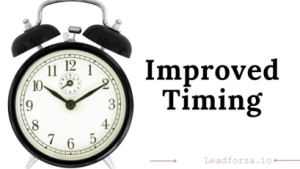
This displays popups at the right moment in the customer journey. Feeling seen and understood then makes the user feel more connected to the website.
Enhanced User Experience
Personalized popups feel more personal and less intrusive. This fosters engagement and boosts conversions.
LEARN How to Avoid Annoying Your Customers and Keep Conversions Rolling
Types of Personalized Popups
The following are types of personalized popups:
- Welcome popups
- Abandoned Cart popups
- Exit-intent popups
- Product recommendation popups
- Behavioural popups
Welcome popups
These popups greet new visitors and offer relevant incentives.
Abandoned Cart popups
These popups remind users about items left in their carts with discounts or incentives.
Exit-intent popups
These popups capture users who are about to leave the product page with personalized offers.
Product recommendation popups
These popups suggest relevant products to the users based on their past purchases or interests.
Behavioural popups
These popups are usually triggered based on the user’s actions and browsing history.
Creating Effective Personalized Popups
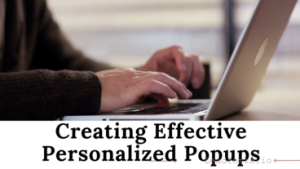
Look at these four easy methods of creative effective personalized popups:
- Data Collection and Analysis.
- Compelling headlines and visuals.
- Clear call-to-action
- A/B testing and optimization
Data collection and analysis
This leverages users’ data, such as users’ location, interests, behaviour, etc., and uses it to personalize the popup.
Compelling headlines and visuals
Here, e-commerce owners craft attention-grabbing headlines and use important visuals.
Clear call-to-action
Instead of leaving the users confused about what to or not to do, this tells them exactly what the e-commerce owner wants them to do with a strong call to action.
A/B testing and optimization
The function of A/B testing is to consistently test and refine popups for maximum impact.
To End With,
As an e-commerce owner, you have seen the dangers of generic popups and the benefits of personalized popups.
You have understood how powerful personalized popups can be – how they can engage your customers and boost conversions.
Thus, do not waste more time on popups that could harm your website, instead customize your popups and see how your engagement and conversions will increase.
CHECK OUT ALSO
- Popup Fatigue: How to Avoid Annoying Your Customers and Keep Conversions Rolling
- Beyond Discounts: 5 Creative Popup Incentives That Will Drive Sales Without Price Slashing
- Personalization Paradox: Striking the Balance Between Relevancy and Creepiness in Popups
- The Secret Tool to Sell More Custom T-shirts on Your Ecommerce Websites
- Popups for Upselling and Cross-selling: Boosting Average Order Value
- Gamification Power: How Interactive Popups Can Boost Engagement and Sales
- 10 Exceptional Strategies to Boost Customer Engagement with Popups Optimization
- Pop-Up Psychology: 7 Underrated Strategies to Skyrocket Conversions in 2024
- Beyond Exit Intent: 5 Advanced Popup Triggers Ecommerce Stores are Missing out on
- Popups for Customer Education and Support: Providing Valuable Resources

